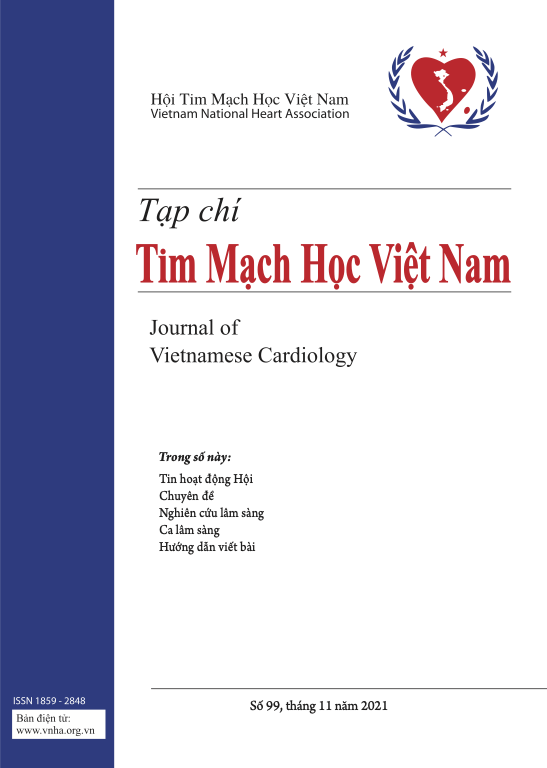Ca lâm sàng gẫy stent tự tiêu Absorb gây giả phình động mạch mũ sau 1 năm can thiệp
Tóm tắt
Năm 2018 đánh dấu 41 năm phát triển của tim mạch can thiệp. Sau 4 thập kỷ từ khi Gruntzig tiến hành ca can thiệp động mạch vành đầu tiên, các phát minh và nghiên cứu liên tục phát triển nhằm hoàn thiện kỹ thuật với mục tiêu cứu sống hàng triệu người trên thế giới. Các thế hệ stent mới ra đời từ stent kim loại thường, kim loại có phủ thuốc và stent tự tiêu. Các stent tự tiêu được coi là có triển vọng với tính năng tự thoái giáng sau thời gian và trả lại lòng mạch vành tự nhiên với các chức năng sinh lý vốn có. Tuy nhiên, stent tự tiêu có các lo ngại về vấn đề tái hẹp cũng như huyết khối cao so với stent kim loại có phủ thuốc [1-3]. Các nghiên cứu đã chứng minh sử dụng kỹ thuật PSP, kỹ thuật đặc hiệu cho stent tự tiêu (BVS specific protocol) có thể giúp giảm được các biến cố huyết khối so với các kỹ thuật thông thường đang thực hiện. Các kỹ thuật này với trọng tâm là nong bóng chuẩn bị (pre-dilated) có kích thước 1.1 lần so với mạch, lựa chọn kích thước stent phù hợp dựa vào các phương pháp chẩn đoán hình ảnh xâm nhập (OCT, IVUS) và nong bóng thêm (post-dilated) tối ưu.
Tài liệu tham khảo
1. Cassese S, Byrne RA, Ndrepepa G, Kufner S, Wiebe J, Repp J, Schunkert H, Fusaro M, Kimura T, Kastrati A. Everolimus-eluting bioresorbable vascular scaffolds versus everolimus-eluting metallic stents: a meta-analysis of randomised controlled trials. Lancet. 2016 Feb 6;387(10018):537-44. doi: 10.1016/ S0140-6736(15)00979-4. Epub 2015 Nov 17.
![]()
2. Wykrzykowska JJ, Kraak RP, Hofma SH, van der Schaaf RJ, Arkenbout EK, IJsselmuiden AJ, Elias J, van Dongen IM, Tijssen RYG, Koch KT, Baan J Jr, Vis MM, de Winter RJ, Piek JJ, Tijssen JGP, Henriques JPS; AIDA Investigators. Bioresorbable Scaffolds versus Metallic Stents in Routine PCI. N Engl J Med. 2017 Jun 15;376(24):2319-2328. doi: 10.1056/NEJMoa1614954. Epub 2017 Mar 29.
![]()
3. DJ Kereiakes, SG. Ellis, C Metzger, RP. Caputo, DG. Rizik, P S. Teirstein, M R. Litt, A Kini, A Kabour, S O. Marx, J J. Popma, R McGreevy, Z Zhang, C Simonton, G W. Stone, MD, for the ABSORB III Investigators 3-Year Clinical Outcomes With Everolimus-Eluting Bioresorbable Coronary Scaffolds: The ABSORB III Trial. J Am Coll Cardiol. 2017 Oct 20. pii: S0735-1097(17)41097-7. doi: 10.1016/j. jacc.2017.10.010. [Epub ahead of print]
![]()
4. Cassese S, Kastrati A. Bioresorbable Vascular Scaffold Technology Benefits From Healthy Skepticism. J Am Coll Cardiol. 2016 Mar 1;67(8):932-5. doi: 10.1016/j.jacc.2015.12.020.
![]()
5. S Puricel, FCuculi, M Weissner, A Schmermund, PJamshidi, TNyffenegger, HBinder, HEggebrecht, T Münzel, S Cook, T Gori Bioresorbable Coronary Scaffold Thrombosis: Multicenter Comprehensive Analysis of Clinical Presentation, Mechanisms, and Predictors. J Am Coll Cardiol. 2016 Mar 1;67(8):921- 31. doi: 10.1016/j.jacc.2015.12.019.
![]()
6. Gregg W. Stone, Alexandre Abizaid, Yoshinobu Onuma, Ashok Seth, Runlin Gao, John Ormiston, Takeshi Kimura, Bernard Chevalier, Ori Ben-Yehuda, Ovidiu Dressler, Tom McAndrew, Stephen G. Ellis, Dean J. Kereiakes, Patrick W. Serruys, Effect of Technique on Outcomes Following Bioresorbable Vascular Scaffold Implantation: Analysis From the ABSORB Trials, In Journal of the American College of Cardiology, Volume 70, Issue 23, 2017, Pages 2863-2874, ISSN 0735-1097, https://doi.org/10.1016/j. jacc.2017.09.1106.
https://doi.org/10.1016/j. jacc.2017.09.1106.">
![]()








